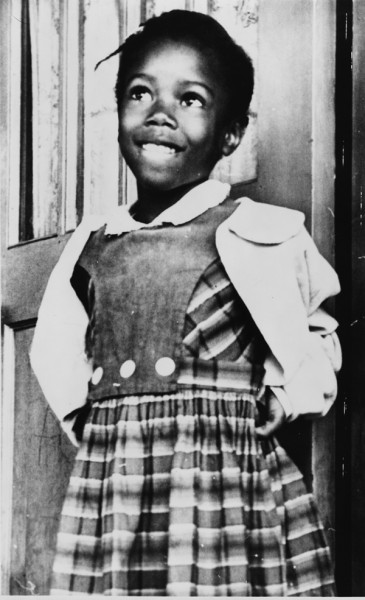Ruby Bridges
Ruby Bridges, along with Leona Tate, Gail Etienne, and Tessie Prevost, was one of the first Black students to desegregate an all-white public school in New Orleans.
This entry is 8th Grade level View Full Entry

Library of Congress Prints and Photographs Division
Ruby Bridges, 1960.
Ruby Bridges rose to national prominence during the New Orleans school crisis of 1960. Bridges, along with Leona Tate, Gail Etienne, and Tessie Prevost, was one of the first Black students to attend an all-white public school in New Orleans. As the United States gradually implemented the federal mandate to desegregate public schools, Bridges became a symbol of the civil rights movement and the tenacity of its advocates. An innocent child at the center of the crisis, Bridges evoked passionate responses on both sides of the debate.
How did New Orleans respond to the Supreme Court’s order to desegregate schools?
Born on September 8, 1954, Ruby Nell Bridges was the oldest child of Abon and Lucille Bridges. She spent her first years in Tylertown, Mississippi, where members of her extended family worked as sharecroppers, earning meager profits for their labors. Looking for better employment opportunities, the Bridges family moved to New Orleans in 1958.
The New Orleans school crisis began in the summer of 1960, but the seeds for it were laid back in 1954. In its decision on Brown v. Board of Education of Topeka, Kansas, the US Supreme Court ruled that racially segregated public schools were unconstitutional and ordered public schools desegregate with “all deliberate speed.” There was deep resistance to desegregation across the United States, even in New Orleans, a city known for its relative tolerance in race matters. Public officials, ideologues, and the New Orleans Times-Picayune staunchly defended racial segregation.
To postpone desegregation, the Orleans Parish School Board repeatedly asked Judge J. Skelly Wright for more time to implement the policy in June and July of 1960. When that failed, they asked Governor Jimmie Davis to intervene and then threatened to close all public schools rather than desegregate them. Each time the school board resisted the order to desegregate, Judge Wright rejected the excuses and threatened to imprison any legislator attempting to thwart the law. Finally, the school board developed a plan to begin school integration using a transfer arrangement. Each Black student who wished to attend white schools was required to pass an intelligence test, which allegedly measured intellectual promise. The families of the Black students also underwent an extensive background check. White students who chose to attend a Black school, in contrast, had no such requirements.
The school board planned to integrate grade by grade, beginning with kindergarten and first grade. Four six-year-old Black girls were selected to desegregate two elementary schools, both located in the white, working-class Ninth Ward neighborhood of New Orleans.
Ruby Bridges was assigned to William J. Frantz Elementary School, while Tate, Prevost, and Etienne were to attend McDonogh No. 19 Elementary School. The children were set to start school in September 1960, but the desegregation date was delayed until November 14 to give the schools additional time to prepare.
How did the public respond to Ruby attending Frantz Elementary?
As soon as the girls entered their schools, a crisis erupted. Pro-segregation parents, encouraged by the Louisiana legislature, the Orleans Parish School Board, and white supremacist politicians like Leander Perez organized a boycott of the schools and bullied other parents into keeping their children home. “Cheerleaders,” as they called themselves, stood outside of McDonogh and Frantz and harassed parents sympathetic to integration. The cheerleaders screamed insults, destroyed property, and splashed paint on the homes of sympathetic families. They even tried to get some parents fired from their jobs.
During this crisis Ruby Bridges became the focus of public attention. Every day she walked through a gauntlet of bitter hatred. Outwardly she appeared to handle the stress well. She remained attentive, good-natured, and calm throughout the crisis. Her mother and father argued about continuing to send her to school but eventually agreed that Bridges had become a role model for other children in the South.
On November 14 and for the rest of the school year, Bridges required the assistance of federal marshals who escorted her to and from school. A psychiatrist, Robert Coles, was also hired to counsel Bridges through the trauma. After one protestor threatened to poison her food, Bridges stopped eating the lunches her mother prepared for her. Her persistence was immortalized by Norman Rockwell in the painting The Problem We All Live With. As white parents continued their boycott, Bridges was the only student in attendance at the school between January and May 1961. Tate, Prevost, and Etienne faced similar abandonment by white families at their elementary school. Despite the crisis, the process of desegregation continued the following school year. The courts told the Orleans Parish School Board in unequivocal terms that desegregation would continue. Legal challenges by the legislature and the school board continued to fail, and the federal government threatened to use force to uphold the law.
Bridges completed her elementary education at Frantz. She later earned a graduate degree in business and worked for fifteen years in travel and tourism. In 1999 she founded the Ruby Bridges Foundation, which specializes in conflict management and diversity education. She is the author of Ruby Bridges Goes to School, This Is Your Time, and other books about her experience as a child during the civil rights movement. She resides in New Orleans with her husband and children.
